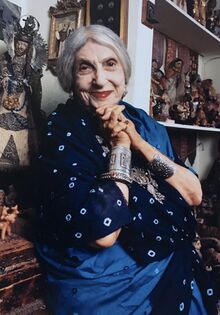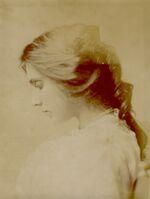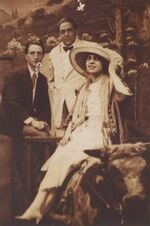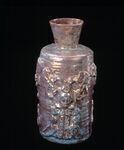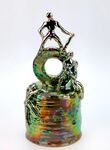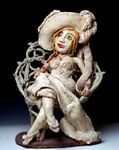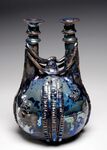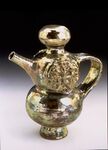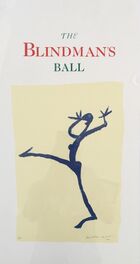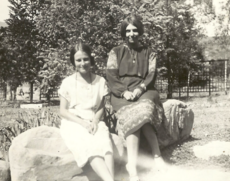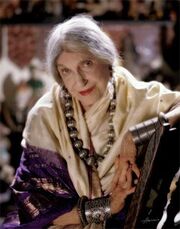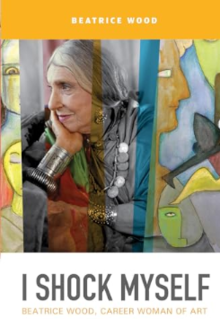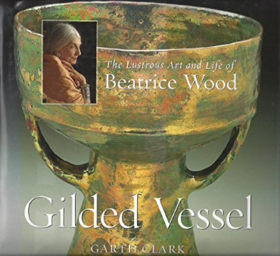Beatrice Wood
Beatrice Wood was an American ceramicist and writer who was influential in the Avant Garde movement. Known as "Beato" and the "Mama of Dada," she was a life member of the Theosophical Society in America. A photo essay of her life appears on the website of the Beatrice Wood Center for the Arts.
Early life
Beatrice Wood was born in San Francisco on March 3, 1893. Her mother was an elegant socialite, Caroline ("Carara") Rosencrantz Wood, and her father, Benjamin Wood, was a successful real estate broker. A son, Jefferson, was born two years after Beatrice. In 1898 the family moved to New York City, where Benjamin became a clothing manufacturer
Mrs. Wood focused on Beatrice's education with the goal in mind of her eventual "coming out" to New York society. At the age of seven she spent a year in a convent in Paris, learning French, and later was enrolled in Ely School, then the most fashionable finishing school in New York City. In 1910 Wood attended Shipley School in Bryn Mawr, Pennsylvania. Wood's formal education was rounded out with frequent trips to Europe. Accompanied by her mother, she regularly visited art galleries and museums and attended the theater.[1]
Her mother's planned trajectory for her only daughter involved a débutante ball and marriage to some suitable man, but Beatrice had other ideas.
Years in France
When Beatrice rebelled against the society life expected of a young lady, her mother sent her to Paris to study drawing at the Julien Academy. Then the young woman took herself off to Giverny to paint in a garret in the countryside where Claude Monet has lived. Her mother moved her back to Paris, but her daughter decided to take up acting rather than to continue painting. She took private instruction in acting and dancing with members of the Comédie Française; Frances Duff taught her how to move and breathe and dress for the theater.[2] In 1913 Beatrice attended the controversial premiere of Stravinsky's Le Sacre du Printemps, choreographed by the great Nijinsky with set design by Nicholas Roerich.
At the outbreak of World War I, the American Consul in Paris insisted that Miss Wood return to the United States.
Years in New York
Beatrice was able to join the French Repertory Company (Théâtre Français) in New York, which her mother found acceptable only because of "her oddly Francophilic pretention that acting in French raised Beatrice above the level of a common thespian."[3] The young actress appeared in over 60 roles from 1914-1916.
In New York Beatrice met Marcel Duchamps, who became famous for the Modernist painting Nude Descending a Staircase when it was displayed at the 1913 Armory Show. He and diplomat Henri-Pierre Roché had a close relationship with Beatrice, which has been called a love triangle. The three of them published a magazine, The Blind Man, and they organized a Dada event, the Blindman's Ball. Duchamps led a group of Dada artists under the patronage of Walter and Louis Arensberg, to whom he introduced Beatrice. The Arensbergs remained her friends for the rest of their lives. Duchamps challenged Beatrice to resume drawing and painting in his studio.
In 1918 she began a brief marriage to Belgian theater manager Paul Renson, whom she met in Montreal.[4] The unconsummated marriage was an attempt to break the hold of Mrs. Wood over her daughter, and lasted only four years, when Beatrice sought an annulment. He proved to be a bigamist and con man.[5]
Miss Wood met Reginald Pole, an actor and director, and with him she became acquainted with Theosophists. Beatrice and Reginald were romantically involved from 1923-1928. Together they read the Theosophical books Thought Forms and Man's Invisible Bodies.[6] When Reginald went to Los Angeles each year to perform as Jesus in a passion play, Beatrice went along, but they were discreet because his divorce was not yet final.
Years in Hollywood
The Arensbergs moved to Los Angeles, Reginald Pole was acting in a passion play there, and so Beatrice took up residence in Hollywood. Her next-door neighbors were L. W. Rogers, his wife Maysie, and sons Stanley and Grayson, who lived at 2033 N. Argyle Avenue.[7]
Another reason for her move to Los Angeles was proximity to Krishnamurti, who held regular spiritual "camps" outside Ojai, a small town surrounded by orange groves and about two hours' drive north of Los Angeles. Wood was a a turning point in her life; disillusioned once again by men and love, confused about her future, without a career, and in need of guidance and spiritual salvation. Krishnamurti's teachings provided here great solace at that moment and for decades to come.[8]
Artistic career
Miss Wood engaged in drawing throughout her life, but ceramics ultimately gave her a means of supporting herself.
Training
In 1928 Wood made a permanent move to California, where she had lived intermittently for several years. Her first exposure to ceramics was in 1933 at an adult education course at Hollywood High School, which she had taken to learn how to make a tea set to match some luster-glaze plates she had bought in Holland. She learned slowly, through trial and error. In 1937, she and a friend, Steve Hoag, pooled resources to build a small house together in North Hollywood. When a flood destroyed their property, the two married in order to apply for Red Cross disaster relief, although it was another loveless union for Beatrice. They were able to build another house with studio and kiln.[9]
A deepening interest in ceramics led Wood to study with Glen Lukens, and then with the renowned potters Otto and Gertrud Natzler.[10] She learned a great deal about forms from Gertrud and glazes from Otto, but ultimately found that she needed a sense of experimentation and spontaneity in her own work.
Move to Ojai
She began to show her pots in great museums, and orders came in steadily. "By 1948 her career was sufficiently established for her to feel confident in building a new house of her own in Ojai."[11] Her cranky husband Steve joined her there.
The first few years in Ojai were exciting for Wood. She met the potters Vivika and Otto Heino, who became lifelong friends and helped her to develop her craft, in particular her throwing skills. In addition she taught ceramics for the Happy Valley School of the Theosophical Society...
Wood began to create her most mature work to date, using a palette of the glorious luster surfaces that flowed like liquid light over her soft, yielding forms The work was so unique that no direct comparison can be made within the ceramic tradition."[12]
Jiddu Krishnamurti had chosen Ojai for his home in 1922, in an effort to find a congenial climate for his brother Nitya, who suffered from tuberculosis. Later he established the Krishnamurti Foundation and the Oak Grove School in Ojai, which continued to be his home until his death in 1986. He was a friend to Beatrice Wood, and he influenced her work.[13] She became very close to the Rajagopals, who assisted Krishnamurti in his work.
Visits to India and Japan
Steve died in 1960. Beatrice missed him after 27 years of companionship, but he had been a difficult person to live with. Shortly afterward, her lifelong friend Helen Freeman also passed. Beatrice entered a new phase of her life.[14]
In 1961, at the request of the Handicrafts Board of India and the American State Department, Miss Wood showed her art in fourteen cities of India, with great success. Eighty of her pots were shipped by air. En route to India, she made a quick visit to Tokyo, where her ceramics were being exhibited in a major department store. She also made stops in Kyoto, Hong Kong, and Bangkok, and loved every new experience. In India she was required to make a speech in each city, and overcame her shyness about public speaking. She was in Delhi at the same time as Krishnamurti and they met for lunch. She also spent several days with Rukmini Devi Arundale in Adyar.[15]
She visited India again in 1965 and in 1972. She adopted the sari as her daily dress, and filled her home with Indian crafts. In 1965 she met Ram Pravesh Singh, who became her manager for the next 25 years.[16]
Additional invitations came for international travel, and Miss Wood attended a World Art Conference in Peru, and a craft meeting in Dublin, followed by travels to Rome, Turkey, and Israel.
Gallery of her works
Miss Wood created ceramics in many forms, including bowls, plates, chalices, and whimsical figurines. Sometimes she incorporated crystals into the bases of the figures. These are some examples of her many pots.
Later years
Miss Wood willed her Ojai house on McAndrews Road to the Happy Valley Foundation. She had purchased the land in 1944 and built the house in 1948.
One day I was asked if I would consider selling it during my lifetime and moving to the Happy Valley land in the Upper Ojai Valley. I loved my house, having designed every inch of it and nursed cactus from tiny pants in to towering figures. But on account of my love for Dr. Besant and my sympathy with her plana for Happy Valley, I gulped and answered, "Yes."[17]
The house was purchased by friends, potters Viveka and Otto Heino. Now 81 years old, Beatrice enjoyed building a new house, and moved in on May 16, 1974.[18]
The art world had renewed interest in her artistic friends Duchamp, Roché, and others. The French government invited Miss Wood to fly to Paris for a huge exhibition of Duchamp works at the Pompidou Center. After visiting many friends in France and Germany, her international travels were over. She did, however, fly east for an exhibition of her early drawings at the Philadelphia Museum of Art curated by Francis Naumann. Garth Clark took over sales of her work in his Los Angeles gallery, and in celebration of her 90th birthday, held a Blindman's Ball featuring Lily Tomlin.[19]
She continued her work with ceramics until 1997. When she was 100 years old, she delivered a commencement address at the Besant Hill School of Happy Valley.[20] Two years before her death, Miss Wood was recognized at the annual convention as "the seniormost Fellow of the Theosophical Society in America in years of age in this incarnation." She was then 103 years old. In a series of resolutions, the artist was acclaimed a "one of our most faithful members" and "a world-famous ceramicist, artist, chocolate connoisseur, and inspirer of young men, as well as a greatly admired, honored, and loved member of the Theosphical Society who throughout her life has exemplified high ideals of art and living."[21]
She died in Ojai on March 12, 1998, nine days after her 105th birthday. She famously attributed her longevity to "young men and chocolate."
Theosophical Society involvement
Beatrice Wood was admitted as a member of the American Theosophical Society on December 1, 1923, sponsored by Russell Lloyd Jones and Leila E. Jones. She and Reginald Pole had visited the Philosopher's Bookshop, of which Jones was the proprietor. Beatrice was initially a national member-at-large, but joined the Service Lodge in New York on November 17, 1924.[22] She was probably considered to be a charter member, as the charter was officially issued on the 15th. The charter was signed by 47 people, not all of whom were named, and within a few years the group had grown to over 70 people.[23] She participated in this very active lodge during the 1920s, serving as sponsor for several new members.[24] In 1926 she would have heard Fenn Germer, an associate of Thomas Wilfred and his "color organ," lecturing on color theory. She herself lectured on "The Life of Madame Blavatsky."[25] Claude Bragdon was another familiar face in the New York Theosophical scene.
The New York area Theosophists were active socially, as well. Young Dora van Gelder stayed with Beatrice Wood in New York, and also visited the homes of the Sellon family and of Robert and Sara Logan early in 1926 in New York and New Jersey. That year, the Logans invited Beatrice to their home near Philadelphia to meet Annie Besant.
Twenty of us were in the Logans' siting room when Dr. Besant entered. She was dressed in white, said a few words to the group, then came over to speak to me. "I am glad Dora has a friend who understands her," she said.
She was referring to Dora Van Gelder, a fascinating young Dutch woman who was visiting me at that time. A tiny creature with a narrow, elfin face and slanting eyes, she was considered one of the finest clairvoyants in the world. In spite of her delicacy she was forthright and outspoken. Married to Fritz Kunz, she lectured widely and became a president of the Theosophical Society. Many were in awe of her, and many were captivated by her charm. I treated her simply as a friend. If she wanted to discuss the best looking waiter at the delicatessen, I was happy to oblige.[26]
Annie Besant challenged Beatrice to seek serenity and steadiness in a probationary period before finding her life's work. This was the summer when Reginald Pole decided to marry another young woman, and Beatrice knew her strength was being tested. She went to Chicago, and "was there then Dr. Besant arrived at the railroad station with Krishnamurti."[27] On August 29, they were all present for the laying of the cornerstone at the new headquarters of the American Theosophical Society in Wheaton, Illinois.[28] Two days later, Beatrice was feeling more at peace after a telegram from Pole verified that he was getting married. She met with Annie Besant's representative, George S. Arundale, and decided thereafter to move to California permanently in 1928. She had already lived there intermittently in the Old Hollywood neighborhood in which the Krotona Theosophical colony was prominent during 1911-1923 before it moved to Ojai in 1924. In the summer of 1926 she participated in Krishnamurti's Star Camp in Ojai.[29]
During the 1940s, Miss Wood served as a member of the selection committee for the Olcott Foundation Awards, a program to encourage creativity among members of the Theosophical Society.
She maintained her Theosophical Society membership until her death in 1998, when she was the "seniormost" member after 75 years of participation.
Theosophical influence in her art
Wood wrote an article for The Star called "Color, Light, and Art" reflecting her interest in the color theory expressed by Theosophists Annie Besant and Charles Webster Leadbeater in their book Thought Forms: "as a person evolves, he desires fresher, clearer colors, for they are a reflection on the physical plane of what is taking place on the inner planes. Leadbeater explains in Man Visible and Invisible (1903) that the colors in the aura of a highly developed man are translucent, pure, and radiant, and those of the lowly developed man are muddy, dark and 'dirty' in hue."
"Translucent, pure, and radiant" are words which also perfectly describe Wood’s luster-glazed vessels. A luster glaze is a fired, glass-like surface on a clay body, where metallic salts on the glaze’s surface give it an iridescent appearance. Wood achieved these brilliant luster glazes through reduction firing which requires the absorption of oxygen from both clay and glaze...
Just as the Theosophical texts advocate for a sort of spiritual cleansing through purification of color, Wood’s life-long study of techniques in luster glazing reflect a similar dedication to a mastery of brilliance. Her luster-glazed vessels in their radiant hues reflecting not only gold but bright purples, pinks, and blues upon closer examination, evoke a sense of alchemical perfection, demanding a kind of reverence only reserved for the sacred and otherworldly. Wood’s extraordinary sense of light and color become even more magnificent as her work is handled and examined— changing colors as the light moves and refracts from the vessel in different ways.[30]
She wrote of her art as her dharma:
Pottery for me is not a pursuit of glory, but a daily discipline of pursuing accuracy. In India it would be called my dharma. Life i dual. There is matter and spirit and one cannot function completely without the other. For creativity, the spirit side, to work, the matter side must be strong enough to hold the spirit side. If the form has cracks, the spirit leaks.[31]
Plays on Theosophical subjects
Miss Wood wrote plays that she intended to be performed by Theosophical Society lodges. In 1931 The Theosophical Messenger reported:
"Beatrice Wood sends word that she has just completed a one-act play dealing with life after death that is suitable for Lodge production. It has four characters and is not difficult to set. She will be glad to send it to any Lodge interested. Perhaps this play would be valuable as a means of spreading theosophical truth.[32]
The following year,
The Theosophical Press will undertake the publication of two Theosophical plays by Beatrice Wood, The Door That Did Not Close and Corridor E, if a sufficient number of orders are guaranteed in advance. The Door That Did Not Close has already been produced with genuine success by several lodges and the second new play comes highly recommended.[33]
Writings
In 1982, Miss Wood published The Angel Who Wore Black Tights, a memoir of her 1930 travels with her dear friend, actress Helen Freeman, to the Star Camp in The Netherlands. It was self-published through Rogue Press in Ojai, and illustrated with charming line drawings highlighted in red. She had written the narrative many years previously, and described it in an introduction:
This is a serious narrative, though some may think otherwise. It is about a trip to Holland taken by two girls, an actress and an artist. It is an experience, not a novel.
The two had been invited by Mr. Jiddu Krishnamurti to visit for three weeks at Castle Eerde in Ommen, where he was giving a series of informal talks to friends. The talks were to be followed later by addresses to thousands who had come form all over the world to be together for one week to listen to his wisdom.
Beatrice Wood and Helen Freeman considered the visit to be of singular importance. That their conversations were gay and light was according to the idiom of their time; in the deeper realms of their beings the impact of Krishnamurti's though was continually breaking through their banter.
A longer autobiography, I Shock Myself: The Autobiography of Beatrice Wood, was published in 1985 by Chronicle Books, San Francisco. Edited by Lindsay Smith, it is lavishly illustrated with photographs of Wood's life and art.
The Union Index of Theosophical Periodicals lists 22 articles written by Beatrice Wood and four about her.
Legacy
The Beatrice Wood Center for the Arts is located in Ojai, California. In addition to museum space dedicated to Beatrice Wood, the center offers workshops in various arts, musical performances, and exhibitions.
The center has hosted such Theosophical events as a 3-day workshop with lectures by Richard Flores and Kevin Wallace on April 12-14, 2013:
This three-day workshop is based upon Thought Forms, the 1901 book by Annie Besant and Charles Leadbeater that inspired Wassily Kandinsky, Piet Mondrian, Paul Klee and countless other artists. Participants will explore the ideas that pre-date and inspired abstract painting through insights into the processes of seeing and recording impressions in form and color.[34]
Museum collections
These are some of the museum with major collections of Miss Wood's work. For a more complete list, see Garth Clark, The Gilded Vessel.[35]
- American Craft Museum, New York
- Museum of Fine Arts, Houston.
- Bruce Jewitt Collection at CalPolyPomona.
- Smithsonian American Art Museum.
- Whitney Museum of American Art. Drawings.
- Santa Barbara Museum of Art. Drawings.
- Los Angeles County Museum of Art.
Awards and prizes
- 1961 – Goodwill Ambassador from the United States to India
- 1983 – Symposium Award of the Institute for Ceramic History
- 1984 – Living Treasure of California
- 1987 – Fellow of American Craft Council Women's Art Caucus
- 1987 – National Council on Education for the Ceramic Arts Award
- 1988 – Distinguished Service Award, Arizona State University
- 1992 – Gold Medal for Highest Achievement in Craftsmanship, American Craft Council
- 1994 – Governor's Award for the Arts, State of California
- 1998 – Named "Esteemed American Artist” by the Smithsonian Institute
Characterizations in film
In his 1962 film Jules et Jim, François Truffaut depicted a love triangle based on a semi-autobiographical novel written by Henri-Pierre Roché in 1953. Beatrice Wood had been in such a relationship with Roché and Marcel Duchamp while working in New York on Dada magazines, but this novel and film were based on a different set of people. Roché did, however, leave an unpublished manuscript called Victor in which Beatrice is recognizable as "Patricia."[36]
The character of Rose DeWitt Bukater, "Old Rose," in the film Titanic was modeled after Beatrice Wood after director James Cameron read Wood's autobiography.
She couldn’t go to the premiere of Titanic so James Cameron and Gloria Stuart brought the video to her. She refused to watch it. She said it was too late in life to be sad.[37]
Additional resources
Archival records
- Beatrice Wood papers, 1894-1998, bulk 1930-1990 at the Archives of American Art, Smithsonian Institute. Includes diaries; oral histories; art works and glaze books; correspondence; personal business records; photographs; and writings, such as drafts of her plays.
- Beatrice Wood Collection at Philadelphia Museum of Art. Correspondence of Conrad C. M. Arensberg, mostly 1978-2001.
Articles
- Beatrice Wood: the Alchemist & California-Cult Artist Turning Mothballs into Gold by Rachel Denniston. Posted in California Art Review on November 20, 2024.
Books
- Clark, Garth. Gilded Vessel: The Lustrous Life and Art of Beatrice Wood. Guild Publishing, 2001.
- Naumann, Francis M., ed. Beatrice Wood: A Centennial Tribute. New York: American Craft Museum, 1997.
- Wallace, Marlene. 'Playing Chess With the Heart: Beatrice Wood at 100. San Francisco: Chronicle Books, 1994.
Video
- Excerpts from Beatrice Wood: Mama of Dada, a 1993 documentary film written and directed by Tom Neff.
- Life Is an Art from Beatrice Wood Center for the Arts.
- Beatrice Wood Permanent Collection Tour by Kevin Wallace. Posted on YouTube on July 21, 2020. "A short video sharing a selection of ceramic works by Beatrice Wood, from the permanent collection of the Beatrice Wood Center for the Arts in Ojai, California."
- Beatrice Wood by David Naranjo. Posted on YouTube on September 30, 2009. Interview with the artist, showing her glazing her ceramics.
- Beatrice Wood at 97 Excerpt by Carole Ewing McCartney. Posted on YouTube on December 8, 2013.
- Beatrice Wood 1993 Commencement Address Excerpt at Besant Hill School of Happy Valley.
- Beatrice Wood Remembers: Dada, Duchamp. Love & Tango. A Conversation with Beatrice Wood directed and written by Steven Watson. Interview conducted October, 1987 in Philadelphia, Pennsylvania. Posted on YouTube on August 10, 2019.
- Elaine Lipworth's Interview with artist Beatrice Wood for her 100th Birthday. 1993. Posted by Elain Lipworth on her YouTube channel on December 23, 2020.
Websites
- Beatrice Wood Center for the Arts.
- [=6279 Smithsonian Institute website] offers a gallery of 32 of Wood's works - ceramics, drawings, and watercolors.
Notes
- ↑ Garth Clark Gilded Vessel: The Lustrous Art and Life of Beatrice Wood (Madison, Wisc: Guild Publishing, 2001), 71.
- ↑ Beatrice Wood I Shock Myself: The Autobiography of Beatrice Wood (San Francisco: Chronicle Books,1985), 60.
- ↑ Clark, 72.
- ↑ New Hampshire, U.S., Marriage and Divorce Records, 1659-1947.
- ↑ Clark, 80-81.
- ↑ Wood, 60.
- ↑ Beatrice Wood in 1930 U. S. Federal Census.
- ↑ Clark, 82.
- ↑ Clark, 84.
- ↑ "Artist Beatrice Wood"
- ↑ Clark, 88.
- ↑ Clark, 88-89.
- ↑ "The Life of Jiddu Krishnamurti" in KatinkaHesselink website.
- ↑ Wood, 144-146.
- ↑ Wood, 152-154.
- ↑ Clark, 95-96.
- ↑ Wood, 163.
- ↑ Clark, 97.
- ↑ Wood, 165-167.
- ↑ Beatrice Wood 1993 Commencement Address Excerpt at Besant Hill School of Happy Valley.
- ↑ "Convention Resolutions," The American Theosophist 84 no.6 (Early Autumn, 1996), 10.
- ↑ Membership Ledger Cards Roll 8 no. 02553-02554 and Ledger Sheets Roll 7 no. 01507-01508. Theosophical Society in America Archives.
- ↑ Service Lodge in Lodge Charter Records. Theosophical Society in America Archives.
- ↑ Membership records. Theosophical Society in America Archives.
- ↑ Service Lodge program schedule for 1926. Theosophical Society in America Archives.
- ↑ Beatrice Wood, 78.
- ↑ Wood, 79.
- ↑ Wood, 79.
- ↑ Wood, 81.
- ↑ Rachel Denniston "Beatrice Wood, the Alchemist Cult Artist Turning Mothballs into Gold" California Art Review posted November 20, 2022.
- ↑ Wood, 133.
- ↑ "A New Play," The Theosophical Messenger 19.3 (March 1931), 338.
- ↑ "Occult Plays," The Theosophical Messenger 20.9 (September 1932), 208.
- ↑ "Thought Forms," Beatrice Wood Center for the Arts at Beatrice Wood Center website. Accessed January 13, 2016. See also Biennial website.
- ↑ Garth Clark, The Gilded Vessel: The Lustrous Art and Life of Beatrice Wood Madison, Wisconsin: Guild Publishing, 2001. See page 122.
- ↑ Wood, 165.
- ↑ Sandip Roy, "How I met the real Rose of Titanic" Posted on FirstPost on April 6, 2012. Based on an interview done for India Currents magazine.
